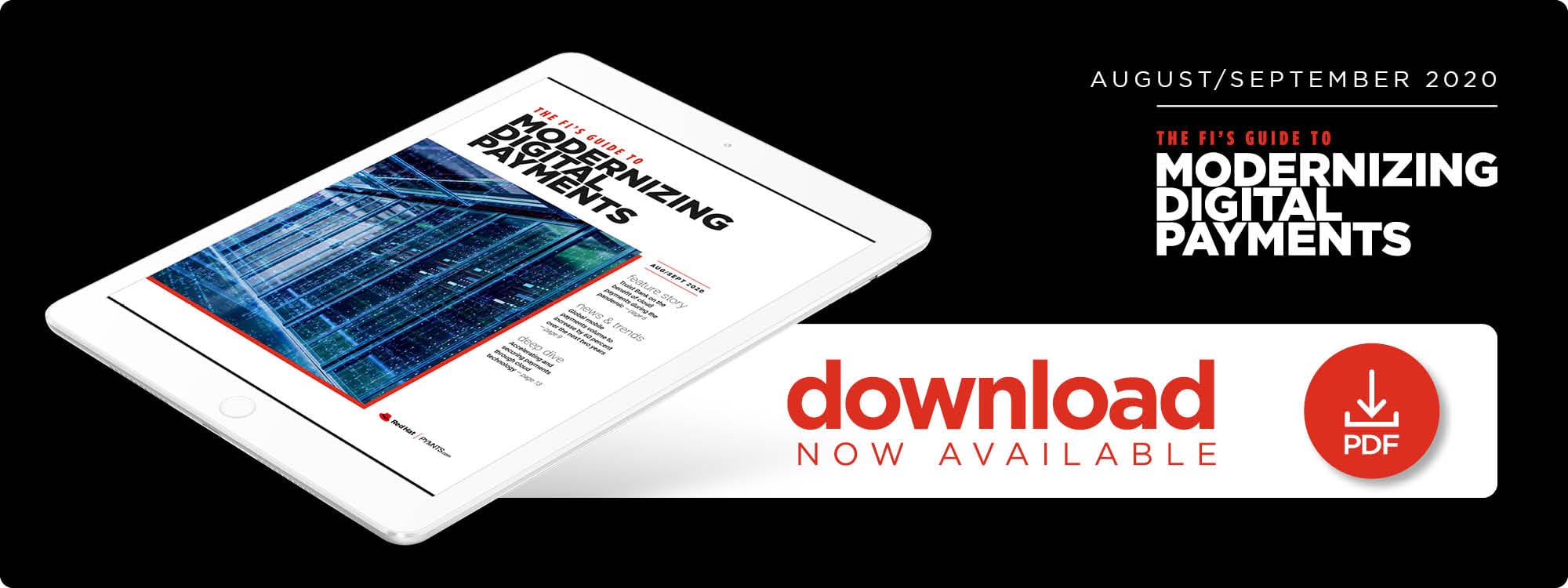Truist Bank On The Benefits Of Cloud Payments Amid COVID-19

The COVID-19 pandemic has accelerated the need for financial institutions (FIs) to quickly scale and roll out faster payment experiences, whether that means offering businesses instant access to loans or enabling access to consumers’ stimulus funds without any wait, says Bryce Elliott, chief information officer at Truist Bank. In this month’s FI’s Guide To Modernizing Digital Payments, Elliott discusses how legacy infrastructure can get in the way and how turning to cloud-based tools can help FIs.
Instant payments are quickly becoming the norm for banks, businesses and consumers, with 82 percent of firms saying these are what they use to resolve their current payment challenges. Even 77 percent of merchants expect that physical payment cards will eventually be replaced by real-time payments. Digital payments are predicted to reach $4.4 billion in 2020, with all sorts of bank customers demanding that these payments grow ever faster, easier and more transparent.
Many banks are leveraging cloud-based payments solutions to meet these pressures, including North Carolina-based Truist Bank, which was formed in December from a merger of BB&T and SunTrust Banks. Its payments platform — like many other banks’ — was developed to meet customers where they are in regard to payments expectations, as unsatisfied customers could easily become former customers.
“In some areas, that’s been a challenge for the industry, but as long as you own that client experience and use the common API technology for any middleware backends, you know, I think that there’s a clear path to success,” said Bryce Elliott, Truist’s chief information officer for enterprise payment technology.
In a recent interview with PYMNTS, Elliott talked about how the company’s corporate and retail customers’ expectations regarding instant payments have been evolving, how cloud technology is being deployed to meet them and how these payments have helped these customers during the COVID-19 pandemic.
How Customer Expectations Are Changing
Both consumer and corporate expectations surrounding payments have changed as transactions have become more digitized, but in different ways, according to Elliott. Customers are laser-focused on speed and convenience, while businesses are more interested in harnessing the analytics capabilities that payments systems can provide.
“Consumers are very used to digitizing payments and making it very simple and easy,” he explained. “[Business] clients, meanwhile, are really striving for their payment data and how to leverage that payment data to be competitive. They’re striving to spend less of their human hours and would rather leverage technology from their financial institutions to provide data and payment information so they can be competitive in their own marketplace.”
The lines between consumer and business payments are blurring, in some cases. Consumer payment apps like Zelle are being used by small businesses more and more often, for example, as they can provide fast and easy payments much more cheaply than a dedicated point-of-sale system.
“Zelle has primarily been a consumer-based solution,” Elliott said. “But we were able to move that to our small business clients and have already seen a significant amount of adoption in the small business spectrum.”
Banks like Truist have their own expectations when it comes to payments as well, largely following the same desires for data analytics that corporations want. These analytics help the banks pinpoint the frictions in payments and work to overcome them so that customers will have a positive experience and a sense of loyalty toward their financial institutions (FIs).
“Leveraging data science is really important, and it’s been a continued focus in all money movement transactions,” Elliott explained. “We’re leveraging information like location, transaction analysis, payment optimization, et cetera, using AI and data science.”
Cloud technology has helped banks in all of these goals, according to Elliott, by helping them accelerate the time to market of new payments solutions and keep these innovations safe from cybercrime.
How Cloud Technology Addresses These Demands
Speed is the name of the game, not only for payments themselves, but in the development of new payments innovations and technologies. Businesses and consumers are constantly looking for banks with the most cutting-edge technologies, and cloud platforms can help banks get these new solutions to market faster than any traditional system.
“What cloud does is really enable speed to market by providing some of the latest tools, technology and scalability and risk mitigants in the environment,” Elliott said. “You can do a lot of things in a cloud environment that would really take you a significant portion of time if you try to do it on premises. From development of environment automation to leveraging the cloud for some proof of concepts to trying out new technologies, trying to stand up a testing environment in a data center is really a thing of the past.”
The other major advantage of cloud technology, according to Elliott, is its cybersecurity capability. The improved time to market for payments innovations the technology offers allows banks to rapidly test and deploy security solutions, potentially staying one step ahead of fraud threats.
“The cloud can provide us the scalability and nimbleness that’s necessary [to fight fraud],” he said. “We continue to learn more and more about what the cloud can bring to us as a scalable and secure platform. Our money movement and our payment platform is a top concern and focus for us to make sure that every dollar that comes in and out is leveraged to a high level of security and traceability.”
One of the most significant recent threats to the banking industry and FI customers comes not from fraud, however, but from the COVID-19 pandemic ravaging the global economy. Cloud payments have proved critical in helping customers come to banks for financial help.
COVID-19 And The Cloud
The economic impact of the COVID-19 pandemic has left countless FI customers in dire financial straits, and they are turning to their banks for assistance in a time of crisis. Banks like Truist are deploying several cloud applications to give them the help they need when it comes to payments.
“The stimulus checks that came out, for example, typically had about a 50 to 60 percent success rate when it came to direct deposits based off of current tax returns and routing numbers and things like that,” Elliott said. “We were able to move that up to 90 percent by implementing some [cloud] technology and leveraging AI capabilities. So when those stimulus checks were submitted, we were able to get them in our clients’ hands as fast as possible when they needed it most.”
Cloud technology also came in handy when distributing loans to businesses from the Paycheck Protection Program (PPP). Truist still had two separate internal payment rails from its pre-merger companies — a potential roadblock when distributing funds — but its cloud infrastructure enabled a seamless front-end experience despite this handicap.
“We were still running on two independent payment rails between the two heritage companies, which we’re not planning on merging until the second half of 2022,” Elliott explained. “But we’ve built technology that not only makes this seamless but also pushed payment information to the respective heritage companies’ GL systems, wire systems and ACH systems. From a client standpoint, they got their money as fast as anybody else, and we were still able to reconcile and do all of the necessary checks and balances, even though we were on two different payment rails in the back office.”
These cloud innovations are on track to make digital payments speedier and more seamless for years to come, even beyond the pandemic. Whatever form the next crisis affecting the banking industry takes, cloud payments will likely play a crucial role in minimizing its impact.

